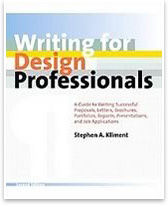 best
practices in risk management best
practices in risk management
Ch-Ch-Changes . . . Managing Risk in the Change Process
At the core of the creative process is refinement. There comes a point,
however, when change brings with it complications such as added expense
and delays, explain risk-management authors James Atkins, FAIA, and
Grant Simpson, FAIA. They explore the intertwining interests of the
owner, architect, and contractor as the design phases flow into construction
and the parties variously choose to welcome, reject, or manage proposed
changes. 
best practices
 Measure Your Office Communications for Impact Measure Your Office Communications for Impact
In his newly released Writing for Design
Professionals, 2nd ed.,
Stephen A. Kliment, FAIA, describes every imaginable type of A/E
communications, including a section on creating an effective Web
presence. In his concluding chapter, excerpted here, he describes
how to measure the impact of that work, including the “fog
index” of your writing. 
Enjoy These Free Educational Offerings from Your AIA
For one week only, visit AIA e-classroom to take a one-hour online
course, “The Ecology of Worship,” and earn one AIA
Continuing Education System learning unit (HSW). Also available—now
and into the foreseeable future—is a new AIA.org page with
more than a dozen 15-minute moderated, taped discussions by some
of today’s leading minds in architecture on topics ranging
from Feng Shui to building information management. 
 The Neuroscience and Architecture of Time The Neuroscience and Architecture of Time
This is a good time to talk about time. It is the beginning of a
new era in the history of AIArchitect, it’s time to begin
another school year, it’s about time for you to come home
mentally from your vacation, and it’s time to stop and reflect
on what neuroscience can tell us about how and why the brain responds
to time. Time, of course, is crucial to planning, designing, and
creating the built environment. It is so much a part of our lives
from our first memories on that we implicitly think of time as
a thing. It is not. It is a concept that we have used our conceptual
brains to define and measure. It is also a part of our hard-wired
brains, and we find manifestations of that biological clock in
organisms as simple as the fruit fly. Join John Eberhard, FAIA,
as he explains time as a function of neuroscience. 
|

 best
practices in risk management
best
practices in risk management Measure Your Office Communications for Impact
Measure Your Office Communications for Impact The Neuroscience and Architecture of Time
The Neuroscience and Architecture of Time